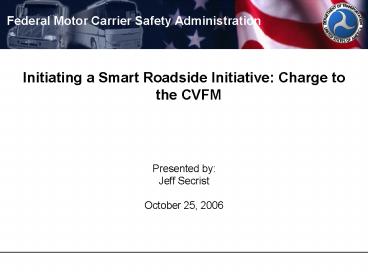Initiating a Smart Roadside Initiative: Charge to the CVFM - PowerPoint PPT Presentation
1 / 15
Title:
Initiating a Smart Roadside Initiative: Charge to the CVFM
Description:
Hazardous Materials (HazMat) operational test. Untethered trailer tracking operational test ... to Secure Safety (COMPASS) Coordinate with this effort ... – PowerPoint PPT presentation
Number of Views:53
Avg rating:3.0/5.0
Title: Initiating a Smart Roadside Initiative: Charge to the CVFM
1
Initiating a Smart Roadside Initiative Charge to
the CVFM
Federal Motor Carrier Safety Administration
- Presented byJeff SecristOctober 25, 2006
2
Outline
- Problem were trying to solve
- Purpose of program
- History of related activities and where we are
now - What the program will address
- Draft vision
- Draft objectives
- Roadmaps
- How can CVFM Help to Support the Initiative?
- Next steps
Outline
3
Problem Fatality Rate Still High
Preliminary
The Problem
4
Problem Congestion Impedes Freight
Mobility2020 Projection
Highway Congestion, 2020
Source FHWA Freight Analysis Framework
The Problem
5
Problem Scarce Resources, Increased Concern
- More commercial vehicles are on the road and
government agencies cannot add sufficient
roadside enforcement staff and resources to
increase significantly the number of manual
inspections and reviews. - The public is increasingly concerned about
container and cargo security, but government
agencies cannot inspect every shipment manually. - To remain competitive in a global market,
commercial carriers and shippers must keep costs
down and work more efficiently. According to
Federal Highway Administration (FHWA) research,
issues include - Travel time reliability
- Regulatory activities
- Fuel prices
The Problem
6
Security Issues
- Increasing container trade could create more
opportunities for terrorist related activities
(bomb in a box) - Increasing cargo movements can also put more
stress on law enforcement and transportation
personnel to maintain efficient flow of freight
through major freight gateways - As volume in cargo increases, number of
personnel, facilities, and ancillary equipment
involved increases - Increasing pressure on law enforcement and other
personnel to complete timely and accurate
inspections of cargoes, vehicles, drivers, and
facilities
Purpose
7
Proposal A New Smart Roadside Initiative
- Save lives by creating a pipeline of research,
testing, and deployment efforts related to
commercial vehicle on-the-road and roadside
activities.
Purpose
8
Plan for New Smart Roadside Initiative
- Establish a new commercial vehicle smart roadside
initiative to organize and focus research,
testing, and deployment efforts related to - Driver assistance technologies and vehicle
controls - Roadside enforcement and compliance verification
- Fleet and cargo management
- Build on light-vehicle Vehicle Infrastructure
Integration (VII) efforts - Improve not only safety, but also mobility,
security, and efficiency
Purpose
9
The New Smart Roadside Initiative Will
ShepherdIdeas Through the Research Pipeline to
Deployment
New alternatives for improving safety, mobility,
security, efficiency
Concept development Prototype Test Analysis
Research-to-Deployment Pipeline
Deployment
Proven operational paradigms, technologies,
policies
Purpose
10
History Related Activities
- Commercial Vehicle Information Systems and
Networks (CVISN Program) is well into the
deployment phase - New roadside technologies are being explored
- Wireless truck and bus inspections
- Hazardous Materials (HazMat) operational test
- Untethered trailer tracking operational test
- Thermal imaging inspection
- Motor Carrier Efficiency Study
- Comprehensive Safety Analysis (CSA) 2010
Partner with this effort to integrate roadside
technologies in new paradigms for improving
enforcement and compliance - Creating Opportunities, Methods, and Processes to
Secure Safety (COMPASS) Coordinate with this
effort to use information from and at the
roadside more effectively - VII Build on this initiative, currently
emphasizing light vehicles
History
11
FMCSAs New Smart Roadside Initiative Will
Perform These Primary Functions
- Define the future vision for commercial vehicle
roadside operations - Coordinate all FMCSA activities related to
roadside operations that require input/support
from the Office of Research and Analysis (RA) - Identify/facilitate high-priority projects for
funding - Shepherd smart roadside ideas through the
research pipeline to deployment - Manage funding for deployment of smart roadside
solutions
The Program
12
Smart Roadside InitiativeStakeholder
Coordination
- FMCSA will coordinate with federal, state, and
industry stakeholders to refine the future vision
of roadside operations for commercial vehicles - Establish a working group within Commercial
Vehicle and Freight Mobility (CVFM) to provide
input about the vision for future roadside
operations - Conduct a one-day working session during CVFM
meeting in September 2006 - Use CVISN Roadside ad hoc team as sounding board
- Identify other mechanisms to help reach out to
industry
The Program
13
Smart Roadside Initiative Coordinate FMCSA
Roadside-Related RA Activities
- Ensure that RA activities support U.S.
Department of Transportation (DOT), Federal Motor
Carrier Safety Administration (FMCSA), and RA
strategic objectives - Maintain a 5-7 year planning horizon to provide a
roadmap for achieving the vision - Support coordination across related RA, FMCSA
and U.S. DOT and other public and private-sector
projects - Provide a framework in which investment/funding
decisions regarding smart roadside projects can
be made - Actively engage federal, state, and private
sector stakeholders
The Program
14
How Can CVFM Help to Support the Initiative
- Establish Working Group of Experts
- Provide Input on the Visions, Goals, Objectives,
and Guiding Principles for the Initiative - Provide Input on Roadside Challenges Related to
Safety, Security, and Productivity that Could be
Addressed Through Technology and Changes in
Business Practices - Work With FMCSA and Other Partners to Identify
and Help Evaluate Potential Technologies and
Operational Concepts that Could Help the
Identified Roadside Challenges
- Provide Input to FMCSA on the Roadmap to Guide
Future Investment in Roadside Technologies - Prepare a White Paper Summarizing the Findings
and Recommendations of the Forum - Assist FMCSA in Convening a Showcase Other Event
to Roll Out the Roadmap for the Smart Roadside
Initiative and Highlight Opportunities for Future
Research, Technology, and Partnerships
Next Steps
15
Next Steps
- Assess the current state re smart roadside
activities, technologies, tests, research,
industry plans - Adopt Vision, Goals and Guiding Principles
- Draft roadmaps for the initiative
- Develop Business Case
- Develop a stakeholder communication plan

